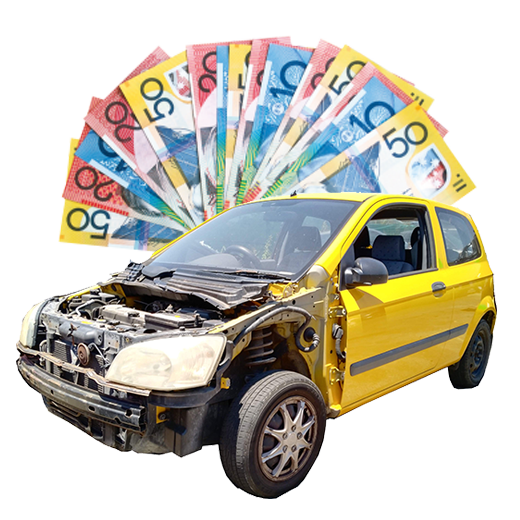When the cost to fix your car is more than it's worth, scrapping it is often the smartest play. This is especially true after a major prang or when a critical part, like the engine or transmission, gives up the ghost. It's a way to turn a dead-weight vehicle into guaranteed cash without the drama of trying to sell it privately.
When Is Scrapping Your Car the Right Move?
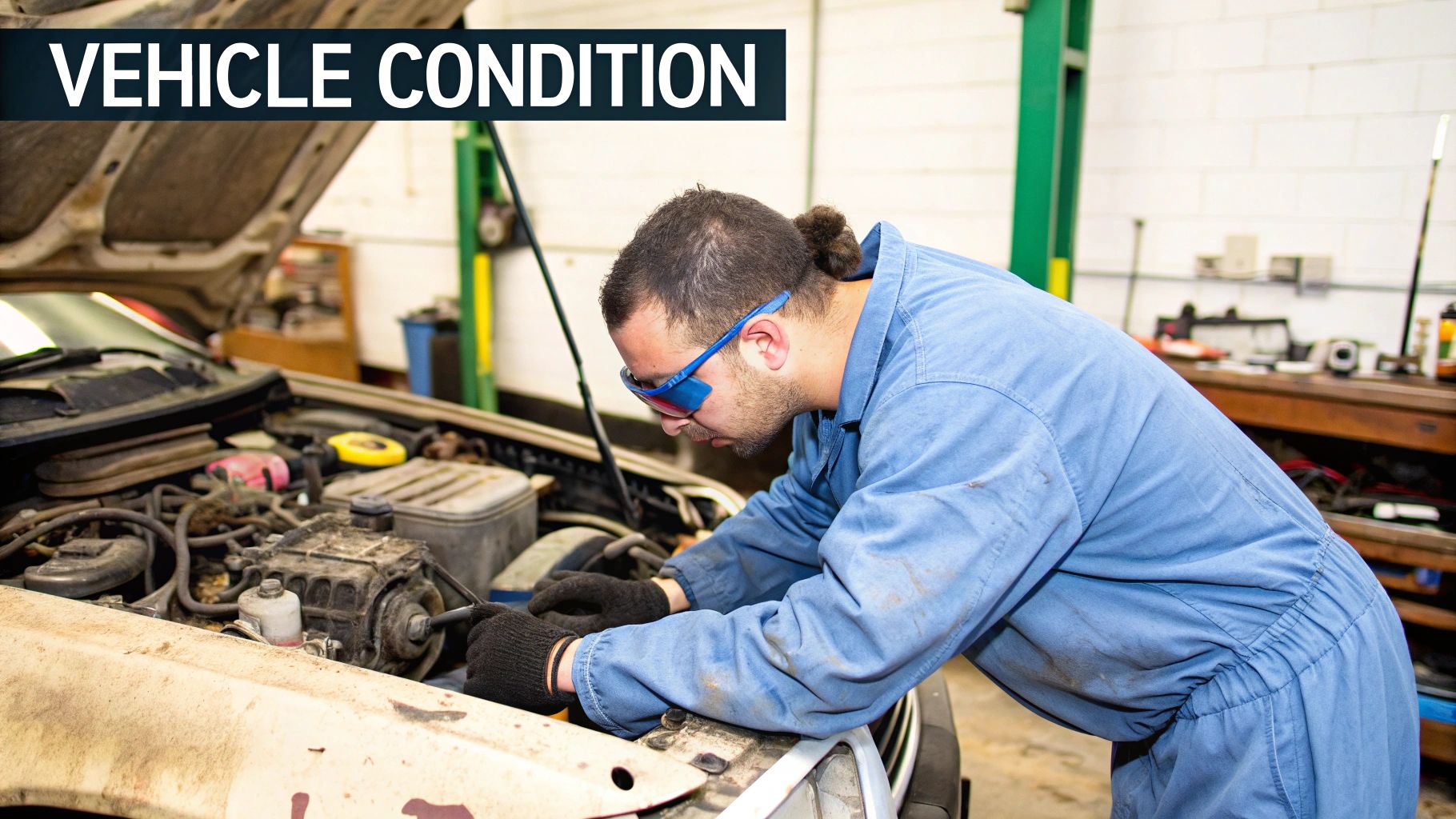
It can feel like a big decision to send your old car to the scrapyard, but sometimes it’s just the most logical and financially sensible thing to do. If you're on the fence, see if your car fits one of these common scenarios where scrapping just makes sense.
The most obvious time is when you're facing a massive repair bill. Let's say your old ute's engine has blown. The mechanic comes back with a quote for $4,000 to fix it, but the whole car is only worth $1,500 on a good day. It's a simple bit of maths—scrapping it means you get paid instead of forking out thousands.
After a Major Accident
A bad accident is another clear trigger. If your insurance company has declared the car a write-off or it's copped major structural damage, it's really not safe to be on the road anymore. Trying to resurrect a heavily damaged vehicle is usually just throwing good money after bad. Scrapping is the cleanest path forward.
My rule of thumb is pretty simple: if the repair bill is more than 50% of the car's market value, scrapping is almost always the better financial choice. You get cash in your hand and avoid any further risk or hassle.
When It's Just Old and Unreliable
Sometimes, a car just gets to the end of the road. It might still start (most days), but it’s constantly breaking down, the rust is getting serious, and it’s become a money pit. Instead of trying to offload a car with a laundry list of issues onto a private buyer, which can be a real headache, scrapping is a clean, simple exit.
Look out for these classic end-of-life signs:
- Constant mechanical issues: It’s spending more time in the workshop than on the road.
- Serious rust or corrosion: The body or frame is compromised, making it unsafe.
- It won't pass rego: The car needs expensive work just to get a roadworthy certificate.
How to Calculate Your Scrap Car's True Value
Figuring out what your old car is actually worth can feel a bit like a mystery, but it’s not just a number pulled out of thin air. The cash offer you get is a careful calculation based on a few key things: the car's weight, the current price of scrap metal, and what valuable parts can still be salvaged.
It All Starts With Weight
The biggest piece of the puzzle is, quite simply, how much your car weighs. At its core, a scrap car is a big chunk of metal. So, the more it weighs, the more that metal is worth. It's why a heavy old ute or a big sedan will almost always have a higher starting value than a little hatchback. More metal equals more money.
This image breaks down the basic maths involved—it's the car's weight multiplied by the current rate for scrap steel, which gives you a baseline for what you can expect.
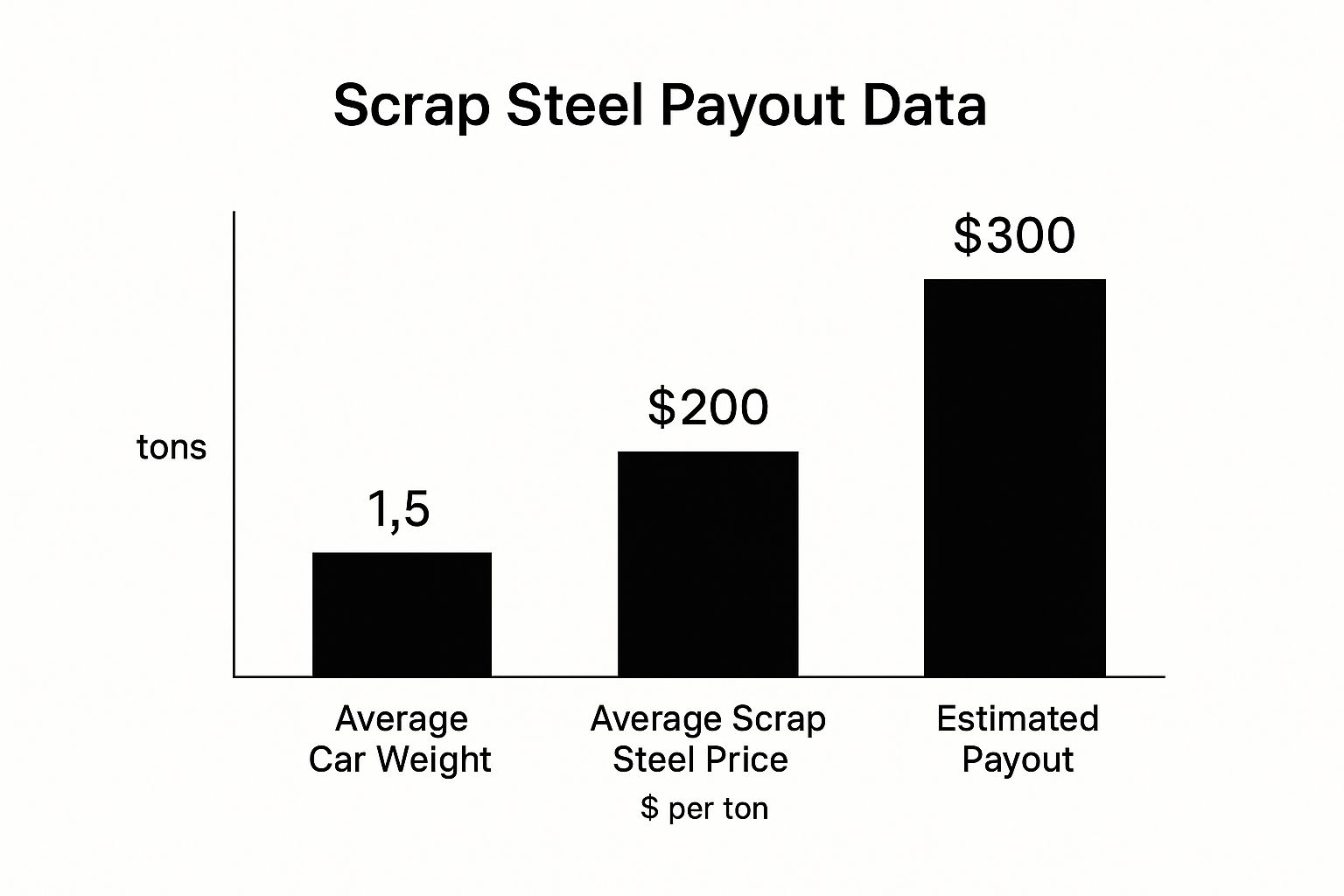
As you can see, even a completely busted car has an inherent value of a few hundred dollars just in its raw materials.
Beyond the Metal: What Really Bumps Up the Price
While weight sets the foundation, the condition of specific, high-value components can seriously boost your final offer. Car wreckers are experts at pulling out parts that can be refurbished and resold, and they'll pay more for a car that has them.
Here are the big-ticket items they're looking for:
- Engine and Transmission: Even if they're not perfect, a working or repairable engine and transmission are gold. They add a significant amount to the quote.
- Catalytic Converter: This is often the single most valuable part of a scrap car. It contains precious metals like platinum and palladium, which have a high resale value.
- Wheels and Tyres: A decent set of alloy wheels or tyres with plenty of tread left can be sold on easily, which adds a nice bump to your payout.
Expert Tip: The final offer is always a mix of the car's scrap metal value plus the profit the wrecker can make from reselling parts. A car that can still limp down the driveway is almost guaranteed to be worth more than one that's a complete non-runner.
The price you'll get for a scrap car in Australia varies wildly depending on what you've got. A completely stripped-out shell might only fetch between $300 and $800. On the other hand, a car with plenty of good, working parts could get you a payout as high as $9,000.
To give you a better idea, here's a rough guide to what you might expect based on the car's general state.
Estimated Scrap Car Value Ranges in Australia
| Vehicle Condition | Typical Price Range (AUD) |
|---|---|
| End-of-Life Vehicle (Stripped, major damage) | $300 – $800 |
| Non-Running Car (Most parts intact) | $500 – $1,500 |
| Running Condition (Major mechanical issues) | $1,000 – $4,000 |
| Wrecked but Repairable (Late model) | $2,000 – $9,000+ |
Of course, the best way to pin down a precise number is to get a few different quotes. For a fast and easy starting point, you can use a scrap car value calculator to get an instant estimate based on your car's make, model, and condition.
Getting Your Car Ready for Collection
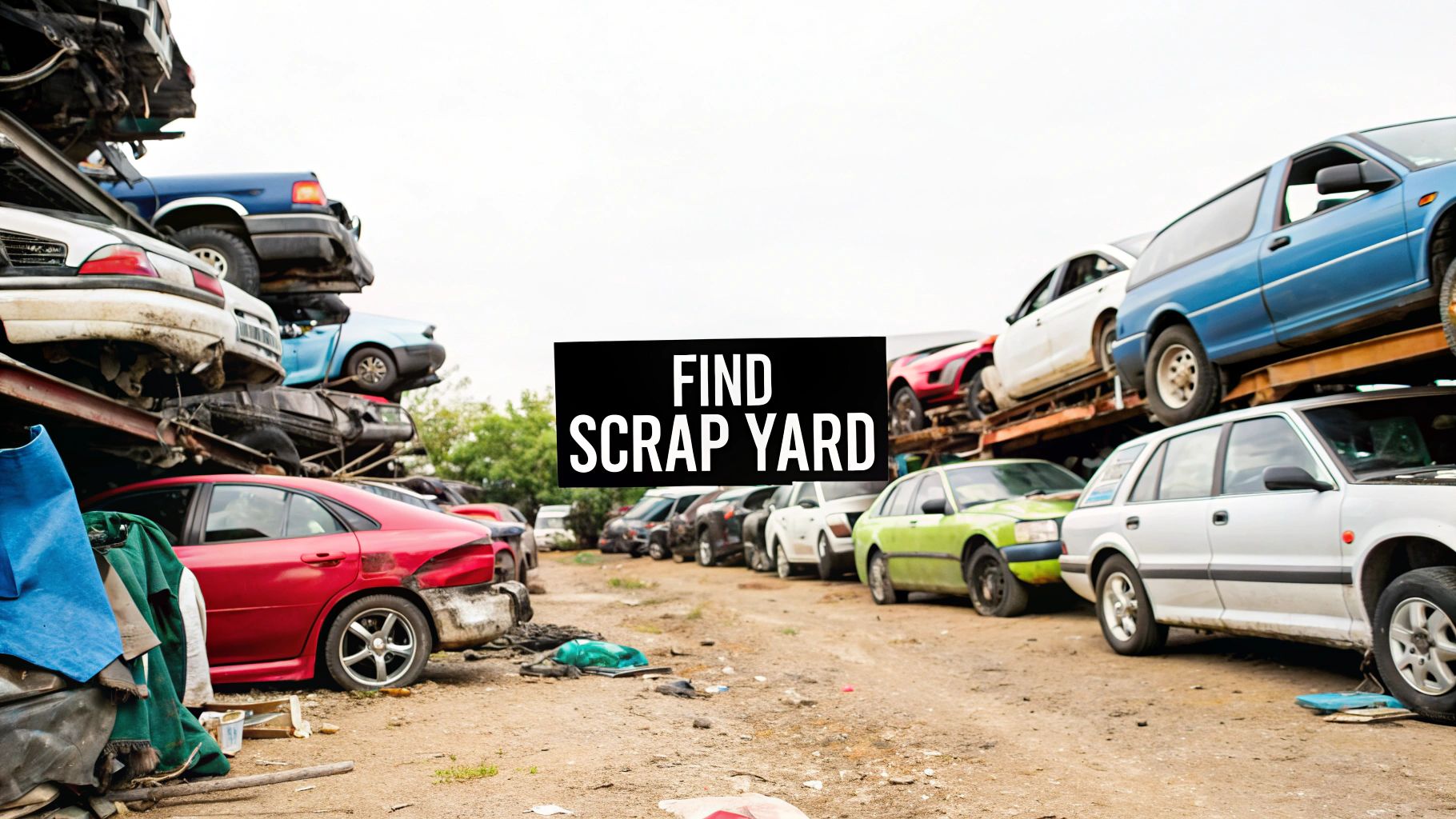
Alright, so you’ve agreed on a price. Now what? Before the tow truck shows up, a bit of prep work will make sure everything goes off without a hitch. These simple steps make the handover a breeze and can even leave you with a little extra cash. This is your last chance to say goodbye to your old vehicle, so make it count.
First and foremost, you need to clear out all your personal belongings. I can't stress this enough: once it's gone, it's gone for good. Go through the car with a fine-tooth comb.
- Glove box and centre console: Check for old receipts, sunnies, or phone chargers.
- Under the seats and floor mats: You'll be amazed at what you find lurking under there after a few years.
- The boot: Don’t forget to lift the carpet and check the spare tyre well.
Maximising Your Return
Now, let's talk about squeezing every last dollar out of the deal. Before you finalise the process of selling your car for scrap, have a think about any valuable parts you might be able to sell privately.
Did you recently splash out on new premium tyres? Or maybe you installed a quality aftermarket stereo? These things can fetch a decent price on their own—often much more than what they add to the car's scrap weight. A quick swap for some old, worn-out replacements is all it takes.
A quick tip from experience: The scrap buyer's offer is for the whole car, based mostly on its weight. They typically don't offer extra for a brand-new battery or a fancy sound system, so anything you can pull off and sell yourself is straight-up profit.
Next, you absolutely must remove your number plates. In Australia, the plates stay with you, not the car. You’ll need to hand them in to your local transport authority to officially de-register the vehicle. This is a crucial step to sever your legal responsibility for it.
What about the fluids like petrol and oil? You can generally leave them as they are. Professional services that handle scrap car removal in Adelaide are equipped to drain everything safely and responsibly as part of their standard process. Your job is just to focus on your personal items and any valuable components you want to keep.
Navigating the Paperwork Without the Headaches
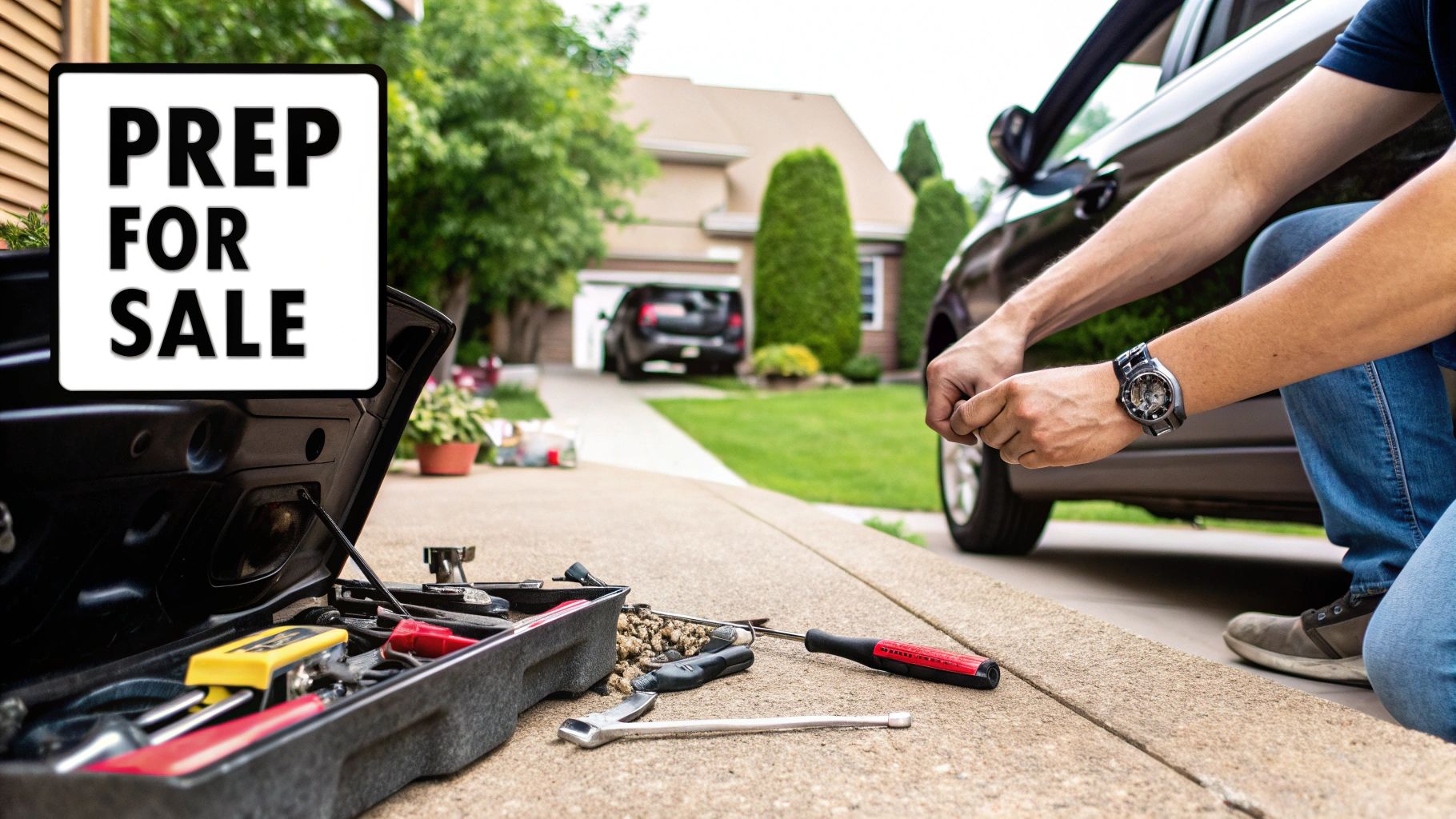
Let’s be honest, nobody enjoys dealing with paperwork. But when you’re selling your car for scrap, getting this part right is what saves you from major headaches down the track. It's your legal shield, protecting you from any fines or issues tied to the vehicle long after it's been towed away.
Think of it this way: the documents create a clean, legal break. The buyer needs proof that you’re the rightful owner, and you need concrete evidence that you’ve signed over all responsibility. It’s all about a clear paper trail.
Your Essential Document Checklist
To make sure the whole process goes off without a hitch, you’ll need a couple of things ready. Any reputable car removal company will insist on this – it’s how they protect their business (and you) from dealing with stolen vehicles.
Here’s the bare minimum you'll need to have on hand:
- Proof of Ownership: This is your car's registration certificate. It's the most critical piece of the puzzle, proving the car is legally yours to sell. No certificate, no deal.
- Personal Identification: A valid Australian driver's licence or another form of government-issued photo ID is essential to verify your identity.
Having these two items ready not only speeds things up but also signals to the buyer that you're organised and serious.
The single most important thing you can do to protect yourself is to lodge a Notice of Disposal. This form officially informs your state's transport authority that you've sold the vehicle, releasing you from any future liability for tolls, fines, or registration.
Finalising the Transfer
When the tow truck arrives to collect your car, there are just a couple of final steps. You'll need to sign the transfer section on your registration papers, but just as importantly, you must get a receipt from the buyer.
This isn't just any old docket. It should be a proper receipt or bill of sale that clearly lists the buyer's business name and ABN, the date, the amount they paid you, and your car's details (especially the VIN). This document is your ultimate proof of sale. Don’t let that driver leave your property without giving you one.
How to Choose a Reputable Scrap Car Buyer
Choosing the right buyer is hands down the most critical part of this whole process. Get it right, and it’s a smooth, profitable transaction. Get it wrong, and you could be out hundreds of dollars and left with a massive headache. You're not just offloading a hunk of metal; you’re entering a legal transaction that should be fair and completely above board.
It helps to know that the Aussie scrap metal market is a big deal. Thanks to a global push for sustainability and strong demand for recycled materials, it's a thriving industry. Steel, which makes up about 70% of your car's weight, is the real prize here. This means there are plenty of legitimate buyers out there, but it also means you've got to be smart about who you choose.
What to Look For in a Buyer
A trustworthy buyer is professional and transparent from the first phone call. Their goal is to make the process easy for you, not to create confusion. From my experience, there are a few dead giveaways that you’re dealing with a legitimate business that cares about its reputation.
Here are the absolute essentials:
- Licensing and Insurance: Any professional wrecker must be a licensed business. This isn't just a piece of paper; it’s your guarantee they follow environmental laws for draining fluids and operate legally. Don't be afraid to ask.
- A Solid Online Reputation: Jump on Google and check their reviews. A long history of positive feedback about fair prices, showing up on time, and clear communication is the best sign you'll find.
- Clear, Upfront Quotes: A good operator will give you a firm quote based on your car's make, model, and condition. Crucially, they’ll stick to it. No last-minute haggling or sneaky "deductions" when they show up.
The best companies provide an all-in service, and that always includes free towing. If someone tries to sting you for collection or tacks on hidden "admin fees," that’s a massive red flag. Politely decline and move on.
Spotting the Red Flags
Just as there are green flags, there are also some pretty obvious warning signs to watch out for. A lot of the same logic applies here as with any other service; in fact, these tips for finding a reputable vehicle service provider are just as relevant when vetting a scrap buyer.
Be very wary of anyone pushing "cash only" deals with no paperwork. This approach often leaves you with no proof of sale, which can cause problems down the track.
Also, sidestep any high-pressure sales tactics. A professional buyer will give you a fair quote and the space to consider it. If you feel like you’re being rushed into a decision, it's usually because their offer won't stack up against the competition. Your best bet is always to take a moment, find auto wreckers near you, and get a couple of quotes to compare. It’s the smartest way to ensure you’re getting the best deal.
Here's the rewritten section, designed to sound like it's from an experienced human expert.
The Final Handover: Getting Paid and Saying Goodbye
Alright, you've done all the hard work. Now for the final, and most satisfying, part: the collection and the cash.
When the tow truck arrives, the driver will give your car a quick once-over. They’re not looking for perfection; they’re just making sure the car is what you said it was and checking the VIN against your paperwork. It's a routine check to ensure everything lines up before they hook it up.
This is also when you'll sign off on the last of the paperwork, usually the transfer section of your registration. Take your time here. It’s easy to rush when there's a tow truck driver waiting, but double-check that every detail is spot on before you hand over the keys and documents. This is the moment the car officially stops being your problem.
How You’ll Get Your Money
With the paperwork sorted, it’s payday. Most professional car removal services are pretty flexible, but you’ll usually see one of three options.
- Cash in Hand: Let's be honest, this is what most people want. It’s fast, straightforward, and you have the money right there and then. No waiting around.
- Bank Transfer (EFT): A great option, especially for higher-value scrap cars. It’s secure, you get a digital trail, and the money typically lands in your account by the next business day.
- Cheque: This is becoming a bit old-school, but some larger outfits might still use them. Just remember you'll have to bank it and wait for the funds to clear, which can take a few days.
Crucial Tip: Never, ever let your car be towed away without a receipt or a bill of sale in your hand. This is non-negotiable. This piece of paper is your only proof that you sold the vehicle. It needs to show the buyer’s details, the amount you were paid, and your car’s VIN.
That final document is your peace of mind. It’s the official end of the road for your old car and confirms you’ve done everything by the book. You can now walk away, cash in hand, knowing the job is done.
Got Questions About Scrapping Your Car? We've Got Answers
Even when you know the steps, it's natural to have a few last-minute questions floating around. Let's tackle some of the most common ones we hear from people all over Australia, so you can go into the process with complete confidence.
Getting these details ironed out now means no nasty surprises later—just a smooth process and the cash you were quoted.
What if I Can't Find My Registration Papers?
This is a really common one, so don't stress. While having the rego papers on hand definitely makes things a bit quicker, it's usually not a deal-breaker.
Any legitimate, licensed auto wrecker can verify ownership using your car's Vehicle Identification Number (VIN) and your driver's licence. They have systems in place for this exact scenario. Just be sure to give them a heads-up when you call to book the pickup, so they know what to expect.
Do I Have to Pay for Towing?
Absolutely not. If you’re dealing with a professional "cash for cars" service, free towing should always be part of the deal. The price they quote you over the phone is the exact amount of cash you should have in your hand when they leave.
Here's a pro tip: If any company tries to sting you with a towing fee or any other "hidden cost" when they arrive, see it as a massive red flag. Reputable operators factor the cost of collection into their offer. Walk away and call someone else.
What Actually Happens to My Car After They Take It?
It's pretty fascinating, actually. Your old car gets a new lease on life through a careful, multi-stage recycling process. It doesn't just end up in a landfill.
- First, it's depolluted. All the potentially harmful fluids—petrol, oil, coolant, brake fluid—are drained and disposed of in an environmentally safe way.
- Then, the salvaging begins. Any parts that are still in good working order, like alternators, mirrors, or even seats, are removed. These are cleaned up, tested, and sold as affordable second-hand parts.
- Finally, it's recycling time. The leftover metal shell is put into a crusher, shredded into smaller pieces, and then melted down. This recycled metal is then used to create brand new steel products.
Ready to turn that unwanted car into instant cash? Auto Removal Adelaide pays up to $8,999 on the spot and offers free, same-day removal across the greater Adelaide area. You can get a no-obligation quote today by visiting their website at https://autoremovaladelaide.com.au.

